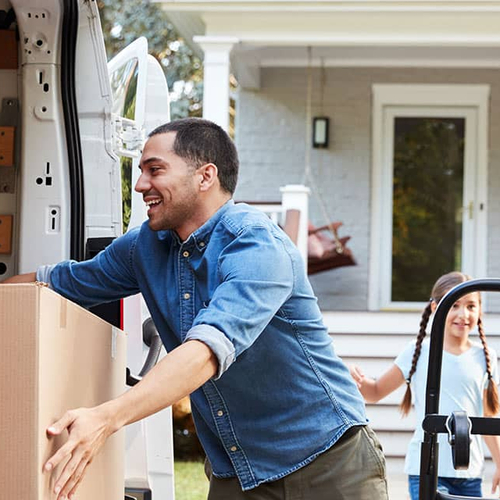How to relocate to another state: A step-by-step guide
Jan 23, 2024
•7-minute read
Moving to a new home can be exciting – and complicated – especially when relocating to another state. Several factors are worth considering in preparation for an out-of-state move, from updating billing information to budgeting for moving expenses. Relocating to a new state can add extra tasks to your moving checklist.
Let’s walk through everything you’ll need to do before you move to another state.
How to move to another state: Step by step
Preparation is key for a successful out-of-state move. Follow these steps to ensure you’re ready for moving day.
Step 1: Establish a moving timeline
The first step to relocating to another state is determining your moving timeline. Estimate how many weeks or months you’ll need to prepare for a move out of state. Establishing a general timeline also means deciding on your moving date. Setting a moving date early in the process helps ensure you have enough time to prepare everything before the move.
Your timeline will depend on the circumstances of your out-of-state move. For example:
- Are you relocating for work and in need a new apartment or house?
- Did you buy a house and need to find a new job?
- Do you need to sell your property while preparing to move to a new state?
- Do you need to buy and sell a house at the same time?
Step 2: Research your new surrounding area
Relocating to another state means adjusting to a new way of life, so you should prioritize learning everything you can about the area you’ll be living in. When researching your new city or town, it can be helpful to check out:
- Your neighborhood and neighboring townships or communities
- Restaurants, shopping centers, parks, recreational facilities and other establishments
- Local school districts
- Public transportation options and low and high hubs of traffic
- The area’s topography
Here are some other factors to consider when researching a new area and relocating to a new state:
- Cost of living in the new state: Consider the average cost of living in your new area. Researching the area’s cost of living can help you find an affordable property. If you’re relocating for a job opportunity, make sure your new salary reflects the area’s cost of living.
- Finding a trustworthy real estate agent: Buying a house out of state doesn’t have to feel daunting. Take it step by step, work with an experienced agent and research your area thoroughly. The home buying process shouldn’t diverge much from the process in your current state.
- Starting the loan preapproval process early: No matter where you’re house hunting, getting preapproved for a loan at the start of your home buying journey is always a good idea. Getting preapproved will check one huge item off your to-do list and make your offers more appealing to sellers.
- Visiting the new area in person: There’s only so much online research can offer. To get a fuller picture, you may want to visit the area in person before moving there. Getting a feel for your new area can help make it easier to find homes and may ease some anxieties before your official moving day arrives. Plus, it gives you a chance to check out local establishments and meet new people or neighbors, so you have an idea of what to expect when you move there.
Step 3: Budget for moving expenses
Moving can be expensive. If you’re relocating for a job, see if your new employer offers relocation assistance.
To keep your spending on track, it’s crucial to establish and stick to a budget. Knowing how much money you have allocated to spend can help you decide when it’s best to pay for a service or take the DIY route.
A few factors worth considering before setting a moving budget include:
- How far away you’re moving and whether you’re flying, driving or using another mode of transportation
- How many people or pets are moving with you and whether you’ll need to board your pets
- Whether you’ll hire professional movers or pack and move everything yourself
- Whether you’ll need temporary storage for furniture and other household items
Once you’ve determined the logistics of your move, it’s time to start budgeting. Up next, we’ll take a closer look at average moving expenses to see how much it can cost you to move out of state, and we’ll help you determine which moving method is best for your situation.
Moving company costs to move to another state
Professional movers can be a big help when relocating to a new state. Hiring a moving company may be more expensive, but a moving company can help streamline the process and help ensure all your belongings make it from point A to point B.
If you want to hire professionals to help with your move, decide which services are essential. Most full-service moving companies offer local and long-distance moving and packing services or provide boxes and packing supplies.
Depending on the distance, moving across the country costs between $2,700 and $10,000. This price range usually includes complete services, like packing and transportation, for a move over 100 miles.
Of course, you can always pack your furniture and belongings yourself to save money on moving costs. Make sure the movers you hire provide out-of-state moving services. The farther away you’re moving, the more expensive it can be to hire a mover.
Truck rental costs to relocate to another state
Renting a moving truck or portable container is also an option for your out-of-state move. Truck rental is a less expensive option, but you’ll be responsible for packing and moving all your belongings. Renting a moving truck can cost anywhere from $300 to more than $2,000 for a long-distance move.
A portable container, or PODS, is another cost-effective alternative to hiring professional movers. The container company typically drops a container off at your residence for you to fill with your furniture and belongings. On moving day, the company picks up the container and transports it to your new house.
Several companies offer portable shipping containers, and the price will vary based on the distance of the move, the size of the container, location and season.
DIY moving costs to travel across the country
Packing and moving everything yourself is the most cost-effective approach to your long-distance move – but it’s also the most labor-intensive option. If you take this route, be as prepared and organized as possible.
DIY moving costs vary, but expenses to keep in mind include packaging supplies – like boxes, packing peanuts, bubble wrap, tape and scissors – plus gas and the cost of staying in hotels and buying meals if you’re traveling across the country.
To help relieve the pressure of moving by yourself, recruit friends and family members to help with packing or transporting your belongings to your new residence.
Step 4: Start packing for your move
Once you’ve budgeted for moving expenses, it’s time to start packing. Set a general timeline for packing to know how much time you have before moving day arrives. Start with home decor, out-of-season clothes, books and other items you won’t need or use until you’ve moved into your new residence.
Prep valuables and irreplaceable items
Next, carefully wrap and pack your valuable items. Consider the best methods for packing items like glassware, dishes, expensive artwork, vintage home decor and other valuables. You may need specialty packing boxes to ensure these items are secure during the move.
As moving day draws near, begin packing personal items or belongings. Consider packing irreplaceable items, like family heirlooms or treasured photographs, to keep them with you during the move. It’s better to be cautious than risk these items getting lost or damaged.
You should also consider what you can sell, donate or trash. Moving is the perfect excuse to clean out any boxes in an attic or basement.
Step 5: Organize and update personal information
Before moving to a new state, cancel any existing memberships or subscriptions and verify that all your personal identification and billing information is up to date and has your new home address.
Some last-minute tasks to keep in mind include:
- Changing your address and forwarding mail
- Getting a new driver’s license or state ID
- Turning off utilities at your current residence (gas, electric, internet, trash services, etc.)
- Notifying your bank, credit card companies, insurance providers and doctors of your move
- Canceling memberships (gym, social club membership, etc.)
- Updating vehicle registration to your new home address
- Changing your voting registration
Step 6: Make final preparations before the move
With moving day just around the corner, it’s time to make any final preparations before you move out, including:
- Running last-minute errands, like refilling prescriptions or taking your car for a tune-up
- Charging all electronic devices for the long journey ahead
- Unplugging any appliances staying in the home
- Defrosting the refrigerator and freezer
- Clearing out any food or perishable items
- Organizing the boxes and furniture so it’s easier for movers
- Cleaning the house
Step 7: Move out of your house
Moving day has officially arrived! But a few final to-dos remain before you can say goodbye to your home. If you hired professional movers, verify that they’re the ones you hired by checking their IDs and then sign any necessary paperwork. If you’re moving everything yourself or with help from friends, develop an efficient method to get everything out of your house. For example, you may want to start with furniture or heavier boxes.
Once the house is empty, do any last-minute cleaning and take a final walk-through. You don’t want to leave anything behind after you’ve relocated to another state. It may also be helpful to take pictures of the residence to document its appearance in case any issues arise when the new residents move in.
All that’s left to do is to ensure all the doors and windows are closed, and then you can lock up the house. You may have to hand your keys over to a real estate agent, the new owners or your landlord before you go.
Step 8: Enjoy your new home
The last leg of your journey is to move into your new home and enjoy your fresh start in a new city. Relocating to another state takes a lot of work, but thorough planning and preparation can lead to a smoother transition to your new home. Now it’s time to unpack and make this new home your own.
The bottom line: Relocating to another state is just a move away
Relocating to another state can be an intimidating process, but with a few easy steps, a clear timeline and a budget, you’ll be putting down roots in no time.
Are you thinking about an out-of-state move? Shop for a mortgage with help from our team of Home Loan Experts to find the right home loan for you.

Victoria Araj
Victoria is a former Team Leader of editorial content at Rocket Mortgage and she held roles in mortgage banking, public relations and more in her 19+ years with the company. She holds a bachelor’s degree in journalism with an emphasis in political science from Michigan State University, and a master’s degree in public administration from the University of Michigan.
Related resources
9-minute read
New home checklist: Everything to do before and after moving day
A checklist for moving into a new home can make for a smooth relocation. Learn everything you need to do when moving with this new home checklist.
Read more

4-minute read
Low-income moving assistance programs
There are many moving assistance programs and resources available to those who need extra help affording moving expenses. Explore your options here.
Read more

4-minute read
Are moving expenses tax deductible?
Moving expenses aren’t tax deductible at the federal level unless you’re an eligible military member. Learn more about the rules for getting this de...
Read more